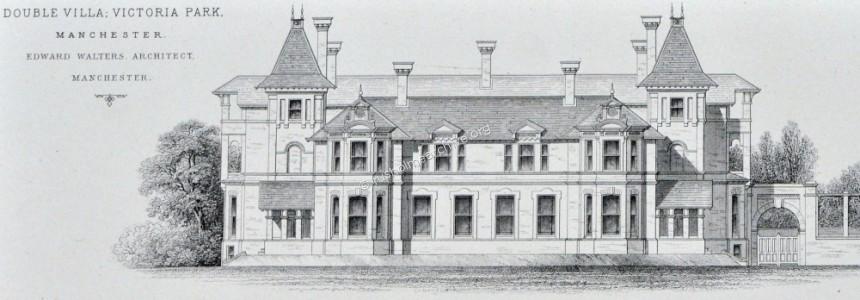Rusholme & Victoria Park Archive

If you have read the page about the 1908 Manchester Electrical Exhibition you will have come across the following paragraph:
‘It certainly does seem to have been a popular exhibition, there were over 300,000 visitors. This success must have prompted the promoters to find a new site in Rusholme, (between St James School & Old Hall Lane, now Manchester Grammar School playing fields) to build the Rusholme Exhibition Hall’.
One of the difficulties in researching this piece of Rusholme history is that the ‘Rusholme Exhibition Hall’ had a comparatively short life of only 3 years. At no time between the opening of the Hall in 1910 and its destruction in 1913 were any maps or documents created from which I could clearly identify the site. One or two references in press articles gave me some indication of the site but a recently discovered photograph has confirmed the location.
The photograph below is a view along Old Hall Lane, looking in an eastward direction and does show the exhibition building on the left of the frame.
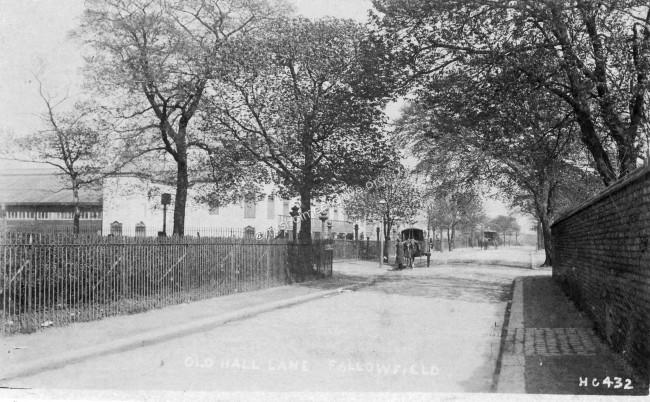
I have edited the same photograph below and this does show a clearer illustration of the Hall with what I presume is the main part of the exhibition area on the left of the frame.
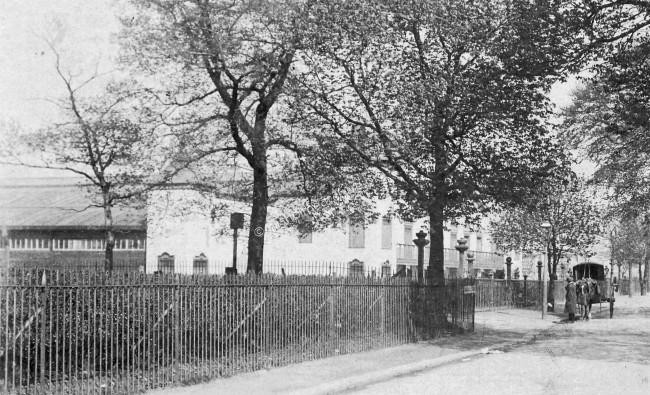
To give another view of the location I have shown an aerial view below with the site outlined in red. (The green line is Wilmslow Road.) This land is on the easterly side of the footpath between 'The Toastrack' and Manchester Grammar School playing fields.
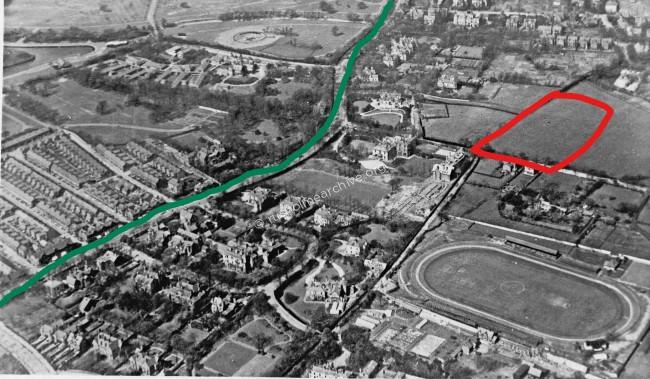
The following report was in the Manchester Guardian, March 22nd 1910.
Exhibition of Industries. An elaborate Manchester scheme.
‘The building of wood and iron that is being put up in Old Hall Lane, Rusholme, for the Manchester Industrial Exhibition in May, promises to be the largest of its kind in the country. The main floor space, apart from the space for subsidiary offices is 100,000 square feet, an area greater than that of the Agricultural Hall in London. The promoters of the venture are the International Trade Exhibitions, who organised the successful electrical exhibition held in the same neighbourhood last year. The scope of this year’s exhibition is, of course, considerably larger. The term “industrial” is widely comprehensive, but it may be taken here, we understand, to have a more domestic significance, the exhibits, without being restricted in any way, will be amplest on the side of things for the home and for the making of homes. Thus, special sections will be given over to the building, furnishing, and similar trades.
But the exhibition will not be without its lighter side. Of this the bandstand in the centre of the hall with seats for 1,000 people round it is good evidence. Some of the best bands have been engaged. In addition, there are to be many independent shows of one kind and another, among them a model of Old Manchester, which will occupy quite a large space. A good deal of trouble has been taken to make it as exact as possible. Another of the Exhibition’s features that is likely to prove interesting is a series of, “Demonstrations of schemes for model houses, sanatoria, crèche’s," and the like. It should be added that 5 per cent of the money received at the turnstiles is to go to such Manchester charities as the honorary committee shall decide. This arrangement is not dependent upon whether the Exhibition makes a profit or not. The Exhibition will be opened on May 12 by the Duke of Argyll, and will remain open till June 30th, possibly longer. Seeing that 300,000 people visited the Electrical Exhibition in Manchester last year, it is hoped this year’s exhibition, with its wider appeal, will prove an even greater success.’
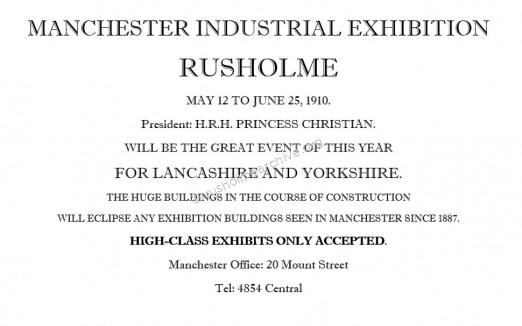
The opening advertisements for the Exhibition listed a wide range of events and displays with headings such as; ‘The Ladies Dress Section should be most attractive’, a number of ‘Crack’ bands would be playing, below I have copied the Guardian advert in three sections.
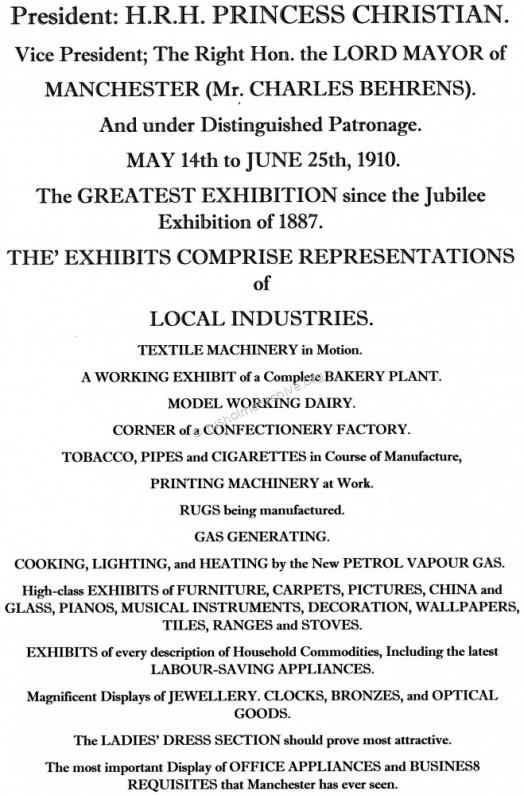
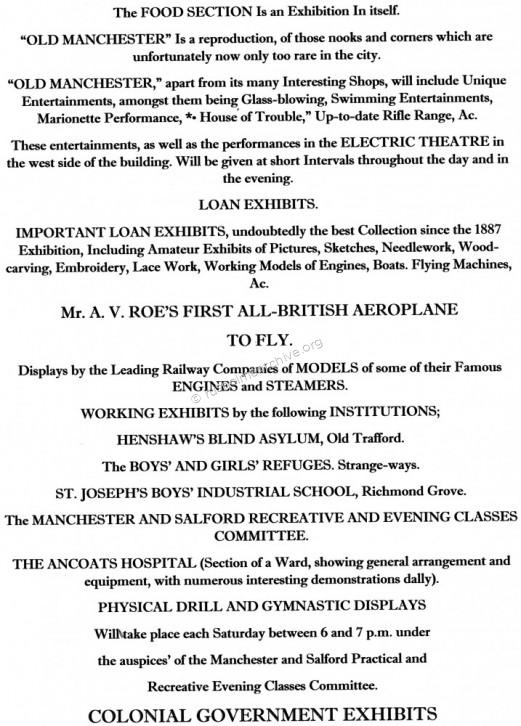
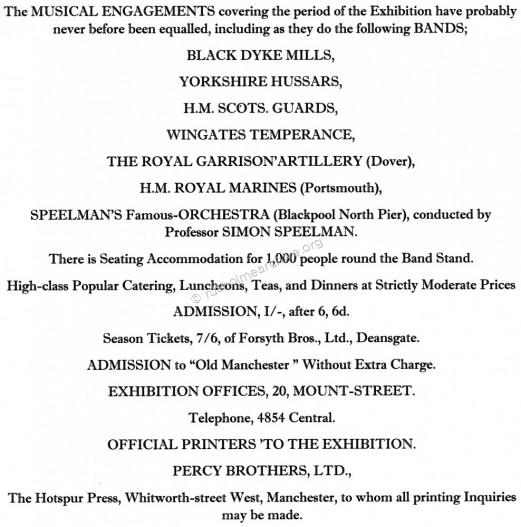
The vibrantly coloured poster below is from the collection at the National Archives, Kew; They have generously given rusholmearchive.org permission to display the image.
The National Archives, ref. COPY1/290 (532)
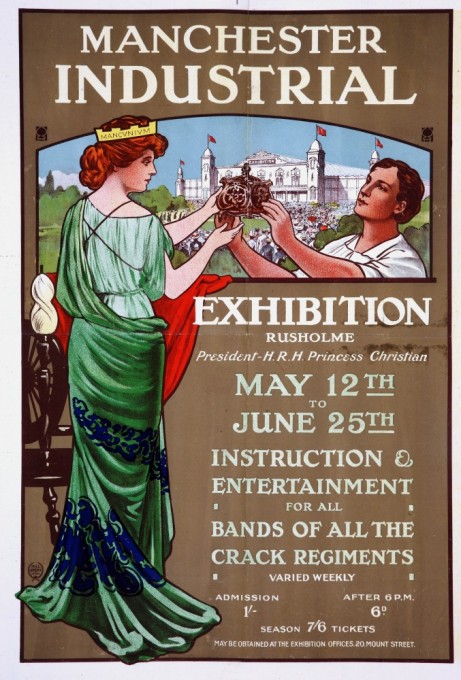
On May 10th 1910, two days before the opening of the Exhibition, King Edward died of a heart attack, a popular monarch his death cast a shadow over the entire nation.
The Manchester Guardian published the following account on May 16th.
INDUSTRIAL EXHIBITION OPENING IN MANCHESTER.
"The Manchester Industrial Exhibition was opened to the public on Saturday. In consequence of the national mourning there was no formal ceremony, but it is understood that the Lord Mayor (Mr Charles Behrens) will attend and declare it open at a date to be fixed after the funeral of the late King. The exhibition buildings at Rusholme cover a large area of ground, and as they are intended to be used for similar enterprises after the close of the present exhibition on June 25 they are of a fairly substantial character. The promoters of the undertaking have decided to hand over 5 per cent of their gross receipts at the gates to Lancashire charitable Institutions. An its name implies, the exhibition is, in the main, devoted to the industrial arts, but there is a collection of paintings and engravings, and music is provided by well-known bands. There is also a loan exhibition of considerable interest. Included in this will be found the first all British aeroplane to fly, made and used by Mr A. V. Roe. There are also models lent by the Lancashire and Yorkshire and Midland Railway Companies and others of engines, ships, yachts, motors, and other mechanical inventions.
One section of the exhibition is called " Olde Manchester,” and is built to give an impression of what the business part of the city was like some hundreds of years ago. One of the links of the past which will attract attention is a portion of Old Garrett Hall. There are nearly fifty shops in this department of the exhibition, and the effect of the whole is exceedingly quaint. There is plenty of variety in the way of entertainment. For each Saturday the exhibition is open physical drill competition and gymnastic displays have been arranged under the direction of the Manchester and Salford Practical and Recreative Evening Classes Committee. The competitors will be drawn from various boys’ and girls’ institutes, clubs, and schools. Specimens' of some of the best work produced in nearly every trade, and handicraft is exhibited, and many processes of manufacture may be seen.
Henshaw’s Blind Asylum, Old Trafford, in a section of the exhibition building, give practical demonstrations of Swedish weaving and tapestry, basket-making, machine knitting, coir mat making, and even shorthand and typewriting by blind persons. The Ancoats Hospital have arranged a model ward, with nurses and attendants, and demonstrations are given of X-ray investigation. At the stand of the Manchester and Salford Boys’ and Girls’ Refuges and Homes, Strangeways, printing, carpentry, shoemaking, and tailoring are seen in operation, and similar work carried on by the boys of SL Joseph’s Industrial Schools is also illustrated.
Altogether the exhibition contains a great deal which is both interesting and instructive.”
I have some very modest items of memorabilia, advertising postcards that have survived 100 years. Perhaps the first postcard is the best, the illustration for 'Thom's Castile Soap, Best in the World.'
I have found the following information about Thom's on the website Graces Guide.
Thom, David, & Company, Limited, Whit Lane Works, Pendleton, Manchester. Telephone: Pendleton 2838. Telegrams: Thom, Manchester. Passenger station: Pendleton, 1 mile. Goods station: Brindle Heath, 1 mile. — Hard, soft and dry soaps for household and manufacturing use; carbolic and laundry soaps, soap flakes, toilet soap, Thom's castile and glycerine.
In the close-up illustration underneath you can see the circular emblem for the 1910 Exhibition.
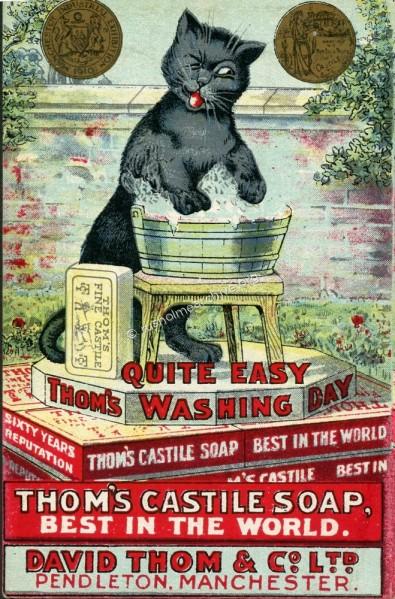
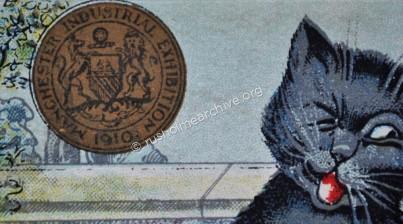
The postcard illustration above is by Louis Wain, his illustrations of cats were very popular. You can read a biographical note at ‘Bethlem – Museum of the Mind’
Another of the items that I have come across relating to the Exhibition is an advertising postcard for a Manchester business, The Gramophone and Phonograph Supply Company.
The image on the postcard below is a rather shocking picture of an elephants foot, (presumably an example of taxidermy), that has been adapted for use as a gramophone. What seems to me to be the most disagreeable is the heading on the card,
“In freedom I walked, in captivity I talk.”
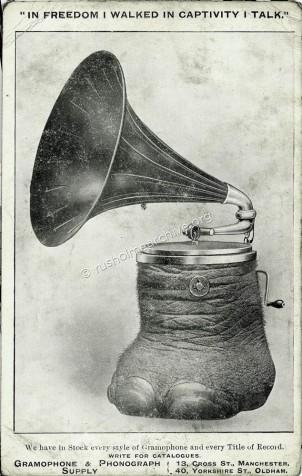
Altogether it does seem a rather disagreeable piece of advertising and I cannot imagine that anyone would find it acceptable today, clearly, however this was not the view of Mr. Jones the proprietor. Located at 13 Cross Street, Manchester, the company were enthusiastic promoters of the *Auxetophone. I can only imagine that judging by the message on the back of the postcard the company must have been displaying the Auxetophone at the Exhibition.
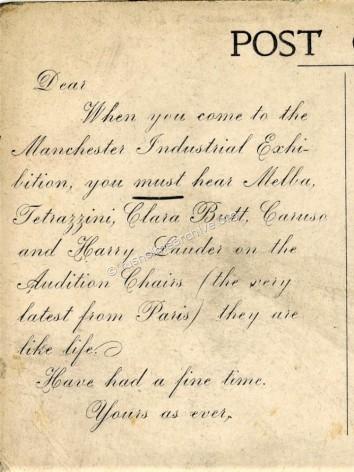
*The Auxetophone was the most successful and powerful mechanical device to amplify recorded sound. It was the product of combined efforts by Horace Short (of Short Brothers' aviation fame) and Sir Charles Algernon Parsons, inventor of the modern steam turbine engine. When playing gramophone records, this reproducer could be used in the open air, in a large hall, or even compete with an orchestra. The Auxetophone represented a radical shift in the function and reception of recorded sound and amplified music, making it possible for the first time in history to successfully play at significantly loud volume in public spaces. Despite endorsements by famous musicians, the Auxeto met with hostility and one critic suggested that the noise was so bad you would need a steam turbine engine to get away from the cacophony.
Another rather small illustrative item that I have found is an adhesive postage stamp sized ‘flyer’ that might have been on postcards and certainly was stuck to various exhibits. As you can see the illustration is like the poster above.
I gave this little 'flyer' to Manchester Library Archives and it is numbered; GB127.m80779
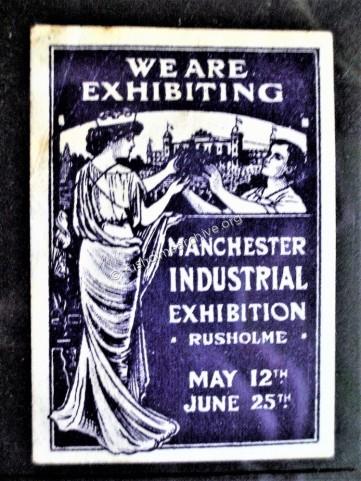
One report that I found when searching the internet does give a further idea of the size of the interior of the Exhibition Hall. The report below came from Flight Magazine, all issues back to 1905 have been digitalized and you can read the article below.
Manchester Aero Club (Model Section), October 1st 1910.
"The last flying meeting of the season was held in the Exhibition Hall, Rusholme, on Saturday last, and proved a great success. Altogether there were 30 competitors, and all the machines were of the monoplane type, proceedings being watched by a fair number of interested spectators.
The first event was the final flights for the season’s aggregate competition, and the winner proved to be D. Wood with his Fleming-Williams machine, with A. R. Whitworth as the runner-up. The second item on the programme was a contest for models under 30 ins. span, and it was won by V. Wood, whose model flew 145 ft., while J. Whittaker was second with 138 ft. The large models completed in the third event, where the honours fell to K. Kinna, his model flying 200 ft., W. S. Williamson being second with 181 ft., and J. Whittaker third with 139 ft.
Two prizes were offered by Mr T. W. K. Clarke for the longest time in the air by a Clarke model, and they were won by K Kinna (17 secs.) and A. R. Whitworth (10 secs).
In the circular flight event the prize fell to A. W. Whittaker, while in a youths’ competition for home-constructed models, the prizes were secured by A. B. Willcocks (183 ft.) and A. K. Whitworth (163 ft.).
The closing item was a point-to-point race round the hall, and three competitors tied, each doing the course in six stages. In the run ofl the models were flown simultaneously, and the winner turned up in A. Whittaker.
A good deal of interest was taken in a large petrol-driven model exhibited by Mr Brent".
One well known Manchester company that had a stand at the exhibition was Thomas Armstrong and Brother.
They were notably manufacturers of optical and other scientific instruments, the postcard below is of their stand and presumably used as a publicity ‘flyer’.
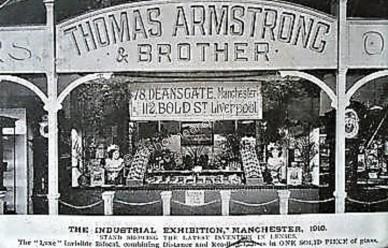
You can read more about he history of this company by visiting the website of the Manchester Museum of Science and Industry
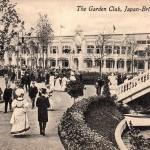 Later in the year the Anglo Japanese Exhibition was staged at the Rusholme Exhibition Hall.
Later in the year the Anglo Japanese Exhibition was staged at the Rusholme Exhibition Hall.
(This followed the immensely successful Japan-British Exhibition which had taken place at White City, London from 14 May 1910 to 29 October 1910. That was the largest international exposition that the Empire of Japan had ever participated in and was driven by a desire of Japan to develop a more favourable public image in Great Britain following the renewal of the Anglo-Japanese Alliance. It was also hoped that the display of manufactured products would lead to increased Japanese trade with Britain. By the time the event closed on 29 October, over 8 million visitors had attended.)
The Manchester exhibition was clearly a modest fair by comparison and the opening was duly reported in the Manchester Guardian;
Opening of Japanese Exhibition by the Lord Mayor, Nov 28th 1910.
"The rattle of the hammers had not ceased in the great Exhibition Hall at Rusholme on Saturday when the Lord Mayor of Manchester opened the Anglo-Japanese Exhibition. Workmen were still busy in various parts of the building, and there were many signs of incompleteness about the Exhibition. There was enough, however, to absorb the interest of visitors for many hours, and what was lacking will be forthcoming in a day or two.
The Lord Mayor, in declaring the Exhibition open, said it was only right that he should elate the reason that led him to associate himself with what was avowedly a commercial undertaking. It was that the promoters had shown themselves commendably interested in the poor of Manchester, and so far solicitous on their behalf as to promise 5 per cent of the gate money, with, a minimum of £160, towards the funds of St. Mary’s Hospital, which to-day unfortunately and, in his opinion, to the shame of Manchester, although built and fully equipped, was not yet accessible to the many needy patients awaiting its opening. He had been looking forward to this exhibition. Things Japanese appealed to him very strongly and took his mind back to one of the pleasantest holidays he had ever had, the few months of 1907 which he and his family spent in Japan. He could not forget the charm and wonder of that visit, the charm of the old, the wonder of the new. The very charm of the life and character of the Japanese made one wonder at the virile strength which lay behind their gentle, truly poetical and artistic natures, and had enabled them in the short space of 40 years to learn all that our so-called Western, civilisation had to teach in the arts of peace and war. They had absorbed all that the West had to say on industrial science, commercial enterprise, and powerful armaments. He had been to Osaka, the Manchester of the East, with its teeming population larger, he believed, than that of Manchester, and he realized that there we had keen competitors, especially in the Lancashire trade. When the Japanese sent goods to China, as they certainly would do in a short time, it would take us all our time to compete successfully with them in that market. Anybody who visited the Anglo-Japanese Exhibition in London must have realised that we had much to learn from the Japanese.
At the close of his speech the Lord Mayor made another reference to St. Mary's Hospital. He should not, he said, be satisfied to pass on the chain he wore to his successor until the hospital had been opened. He did not mean that he should like to be Lord Mayor for a third year. But he had made up his mind that, come what might, we must have that Hospital open within the next few months, (Applause.)
Councillor Thewlis also spoke a few words. He believed that in promoting this Exhibition and in making it succeed, Manchester would have done something to promote an understanding between England and Japan which would have far reaching effects.
Mr J Ando, the president of the Japanese Section, made a short speech in his own language which was interpreted by Mr. A. F. Misluku, the manager of the section.
Before the opening the Lord Mayor and a number of other guests were entertained to lunch in the Exhibition dining hall. There were present, besides those taking part in the opening ceremony, Miss Behrens, Sir William Bailley, Mr Ford Smith (Japanese Consul), the Dean of Manchester, Mr Alderman Carter, Mr J K Bythell, the Chief Constable (Mr.Peacock), Mr. A. M. Samuel, Mr. S. W. Royse, and Mr Walter Stenning (organising manager)."
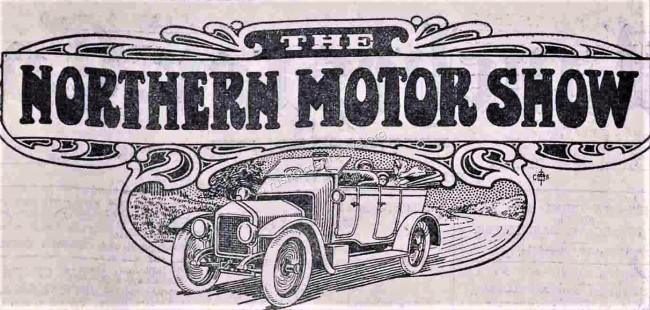
Although the Rusholme Exhibition Hall had a short life of just three years there was one event staged annually that always proved a success, the Northern Motor Show.
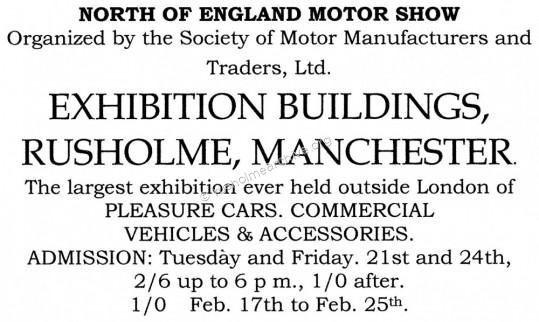
It was first held in February 1911; the Manchester Courier ran an article just before the opening of the Show on the 17th Feb. with the following words;
“A visit paid to the Show Exhibition Buildings in Old Hall Lane, Rusholme, and a good look round on Monday morning last, was sufficient to convince the most sceptical as to the huge proportions and importance of the North of England Motor Show which is to be opened at Rusholme at 11 30 a.m. on Friday next by the Earl of Derby, and which will run for eight days, closing on Saturday, the 25th inst. More than one exhibitor or local motor trader who had attended every show of the kind held in the provinces for many years has expressed the opinion, “It's going to be the best and biggest motor show ever held out of London!”
The postcard below is French and I can only imagine that the small flyer stuck in the corner was perhaps from one of the French Motor Car Exhibitors……??
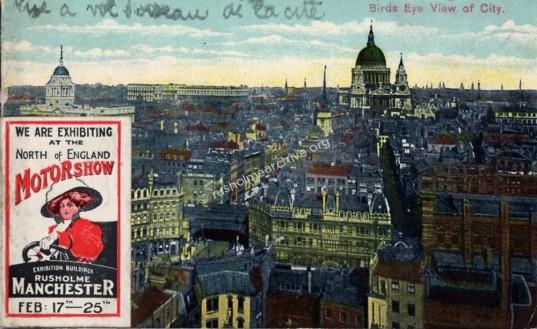
Lord Derby gave a speech at the opening of the Exhibition and said;
“The success of the show was already assured. It had been the practice of the Society in past years to hold exhibitions only in London, and he thought that, generally speaking, they were quite right in concentrating their efforts on one central show. It was essential that exhibitors should not be put to too much expense, or they would be deterred from exhibiting, and as a consequence the high standard of the show would suffer. Still, it might be an advantage sometimes to go out of the narrow domain of London, and as the Society had decided to do that he was glad that they had come to Lancashire and to Manchester, (Hear, hear.) The Society evidently recognised that Lancashire was the finest county in England, (laughter), and that it was the centre which would bring most grist to the mill. In Manchester they were not only in the largest commercial centre of the kingdom, but they were within easy reach of the big manufacturing towns of the West Riding.”
Concerning the future of the motor industry, Lord Derby said; “He believed that the commercial vehicle of the future would be the motor, and the increase in the number of commercial motors on the road, compared with five years ago, was extraordinary. Here they had an exhibition which brought before them the motor for pleasure and the motor for business, and he thought it would not suffer by comparison with any exhibition either in London or abroad”, (Cheers.)
I have set the final part of the speech in italics - Lord Derby was quite right in his anticipation of the growth of commercial motor vehicles!
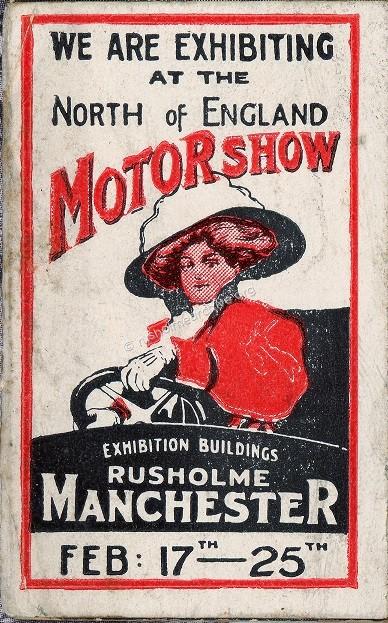
The Manchester Guardian reported on the 20th Feb that the Motor Show was proving popular;
“The North of England Motor Show at the Exhibition Buildings, Rusholme, Manchester, is proving a popular attraction. Thera was a large number of visitors on Saturday. The show is evidently appreciated as a means of learning the newest and best features of motors both for pleasure and commercial purposes. It gives an opportunity that has previously been limited to London of comparing different makes and types, and it offers a wide range of choice to the intending purchaser”.
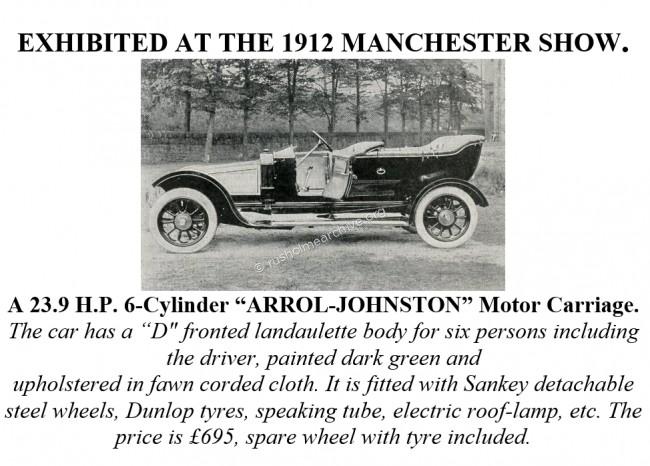
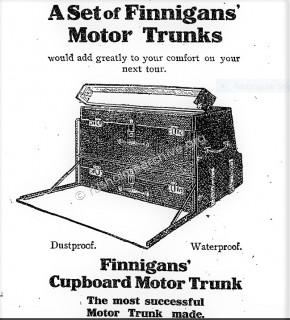
During the 30+ months of the Exhibition Halls remaining life there were a variety of exhibitions, I have not endeavoured to trace all of them, but some have particularly caught my attention.
It may be an exercise for the future to digitally research local newspapers and create a chronological list of all the different exhibitions. The one characteristic that I have noted about all the exhibitions is the absence of ‘canned music’ technology, live bands were always featured as an attraction.
An exhibition in March 1911 was the Ironmongery and Hardware Trades Exhibition. Below is the small stamp that was used, (I presume) for promotional purposes, and then beneath the flyer a report from the Manchester Courier where the final note refers to the Marines providing music.
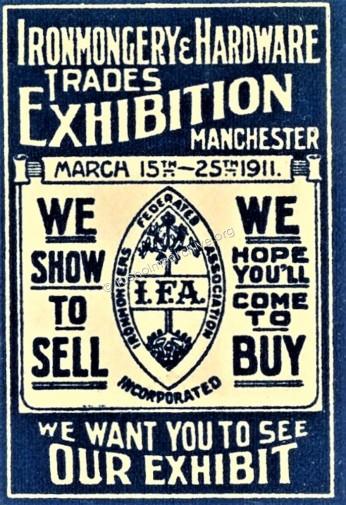
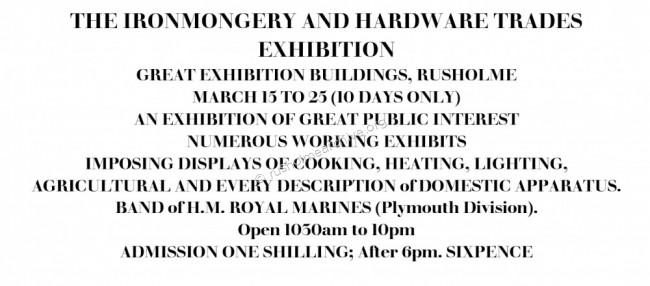
THE EXHIBITION, RUSHOLME; HINTS FOR THE HOUSEHOLD.
The Ironmongery and Hardware Trades Exhibition which is being held at Rusholme has had a large daily attendance of visitors since it was opened. The exhibition is now in full swing, and will continue till the 25th inst. Retail business is not allowed, the purpose of the exhibition being to bring all the trade novelties and latest designs before the notice of the dealers, but every effort has been put forth to make the exhibition interesting to the ordinary public, who are thus afforded an opportunity seeing all of the new goods for the 1911 season at the earliest possible moment. All the smartest and best things in household equipment are to be seen in an extensive range quality and pattern, and there are some new appliances which should win favour with the householder for their labour-saving qualities. The Manchester and Salford Ironmongers’ Association have stand in the exhibition giving the names of local shopkeepers through whom any article seen in the exhibition can be obtained. The ironmongery and hardware trades cover a large field, and included in the exhibits are displays of furniture, pictures, and pottery on the one hand and agricultural implements, manufacturing tools, and machines the other. The Ironmongers’ Association are hopeful that the exhibition will great be of commercial advantage to both buyers and sellers, it affords an opportunity for the meeting of those who conduct the transactions between the manufacturer and retailer. All gas users would do well to see the new types of gas mantles exhibited at the stands of Messrs. Curtis & Harvey Ltd. (69 and 81). In the upright mantles the “patent metal top” is an entirely new departure, the metal ring at the top rendering the mantle more durable, the fabric held equally all round, making the head—usually the weakest part mantles—the strongest point. The metal top also ensures the mantle hanging perfectly steady on the rod. It is made in all sizes. The loom woven fabric of the mantle is especially strong. The inverted Iris brands are made in the ordinary and bijou and fit any burner. The public will find further interest in the working exhibits, such as those showing the manufacture of pottery, while entertainment is provided by the band of the Royal Marines (Plymouth Division), who play afternoon and evenings while the exhibition is open.
Another exhibition that I noted in 1911 was the Greek Currants and British Fisheries – a curious mix but they clearly were instructive and certainly played a role in cookery education.
The following is a report from the Manchester Guardian Oct 26th 1911;
“The Greek Minister (M. Gennadius) visited Manchester again yesterday accompanied by Madame Gennadius, who, in the evening, presented the prizes gained by girl pupils associated with the Exhibition. Besides the Minister and Madame Gennadius, there were present the Greek Consul in Manchester (Mr. S. Hazzopulo), the Vice Consul (Mr. Petros A. Kestorides), Major and Mrs. Wood, Captain and Mrs. Harrison, Sir John Wrench Towse, of the Worshipful Company of Fishmongers, and Mr. Edward Bowron.
Madame Gennadius handed the prizes and certificates to the successful pupils, and afterwards the Greek Minister expressed the pleasure which it had given him and his wife to come from London to Manchester. They were especially gratified to see that a large number of young people had merited the award of prizes.
Details in connection with the cookery competitions had been distributed in the Manchester schools by permission of the Education Committee, and the children prepared their exhibits at home, and sent them to the Exhibition where they were judged and shown. There were some 2,000 competitors who prepared exhibits in fish cookery and currant cookery and were ranked in three classes from girls under 12 to girls over 14. Miss Crass, chief instructor in cookery under the Manchester Education Committee judged the exhibits.”
In December 1912 the British Columbian Government sponsored an exhibition entitled ‘Apples’, see below notice.
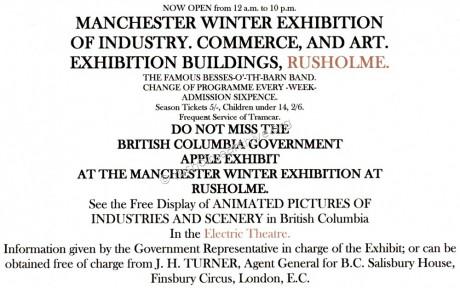
In March 1912 the Manchester Guardian printed a report about the Building Trades Exhibition, this was not exactly an ‘Ideal Homes Exhibition’ but does offer a brief insight into how new homes were thought about.
HOUSE AND HOME: THE NEW EXHIBITION AT RUSHOLME
"The Building Trades Exhibition at Rusholme, which opens to-day, is here by invitation. It is practically the same exhibition, on a very slightly reduced scale, as the London Building Trades Exhibition, held first, at the Royal Agricultural Hall from, the year 1895 to 1905, and after that at Olympia. The promoters have been constantly approached, during the last ten years in the hope of getting them to hold an exhibition of this sort on a large scale outside of London. Other cities were proposed, but Manchester offered the best accommodation for such a large undertaking in the Exhibition Hall at Rusholme.
POINTS FOR THE BUILDER.
One recognises many of the stands which were at Olympia last year, and no doubt the list of exhibitors is very much the same. Although this exhibition will be a popular one, it is intended also to give points to the architect and the builder. Everybody who lives in a house will be interested in this collection of the latest domestic things. The constructional exhibits are more recondite, and things like cement mixers, tar sprinklers, and portable railways will appeal to those who build for a living. The exhibits at an exhibition of this sort require an elaborate setting. If someone has a good paint he has to build a room to show it off. There is indeed a charming “Adams” room built for the sole purpose of exhibiting a well-known distemper on the walls. Brickmakers build houses as though they really meant them. One firm has built unto itself a house that rears its chimney well out of sight amongst the rafters. It is built of delightful hand-made bricks, and it is a very attractive thing to look upon. One of the most attractive stands is that of a firm of paint manufacturers. The stand is the foredeck of a battleship. There is the funnel and the navigating bridge and two big guns all painted an unfamiliar white instead of the usual battleship-grey.
One of the eights of the exhibition is an old English garden, delightfully laid out and occupying a very considerable proportion of the available floor space. Passing under a pergola one enters extensive grounds of green felt grass with cocoanut matting paths. They contain an old English shingle-roofed summerhouse and also a Japanese summerhouse, but the English one, in stout oak with elm weather boarding and windows of glass, would seem to be the best for England. The wooden seats and tables in this old English garden are models of simplicity and elegance and their white paint goes well with, the green fen.
THE USE OF TERRA-COTTA.
The garden contains a good many vases and well-heads of marble and terra-cotta and one or two fine copies of old Italian marble seats. For the most part these ornaments come from Italy and are copies of old work. Although our terra-cotta has improved enormously in recent years, the English clay will not give a finished surface like the clay which comes from Italy. Many firms exhibit terra-cotta in all colours, shades, and shapes. One firm shows an ingenious device for building up terra-cotta facing tiles with a reinforced concrete wall. The whole fabric is built up together, as the difficulty with terra-cotta is that it warps and twists. This method seems to be superior to the old hollow block method. In a smoky city like Manchester Teracotta has immense advantages, for it can be easily washed. There are many exhibitions of various methods of reinforcing concrete, but they do not vary a great deal. But it is clear that ferro-concrete is being used more and more. Whereas at one time it was only used for very large work, it is now used for practically all kinds of buildings, large and small. The usual method of building up walls in ferro concrete is, of course, to build wood sides to the wall and pour in cement, the tension bars and wires being previously in position. One exhibitor here has a different method. He built a detached villa some time ago by moulding the walls, including a classic cornice, flat on the ground with their lower edges in position. They were then hoisted and bolted at the angles and finished off with a coat of cement. In this way a house can be built much more quickly than by most other methods of ferro- concreting and, of course, ten times more quickly than in brick.
MORE LIGHT.
An excellent display of light increasing windows ought to interest Manchester people. At one stand there are shown windows capable of collecting the light from odd angles and distributing it over the room. They show also an excellent little arrangement for ventilating a cellar right in such a way that a passer-by cannot possibly throw a match into it, a contrivance which is said to be needed. But a Building Trades Exhibition like this suggests all sorts of new needs, and then shows how they can be supplied. It is full of hints for the man who is going to build his own house.”
In July 1913 there was a ‘Feast of Roses’ when the Royal Botanical and Horticultural Society of Manchester held their first show in Rusholme instead of the Botanical Gardens at Trafford, (now known as the ‘White City’).
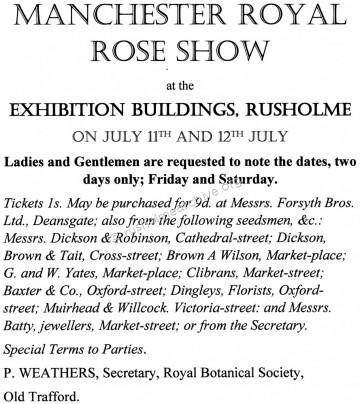
The Manchester Courier reported from the Rose show that;
“Not only does the quality of the exhibits and the general display surpass many of the previous exhibitions but yesterday there was every indication that the promoters will be adequately compensated for their experiment in transferring the exhibition from the Botanical Gardens to the Rusholme Exhibition buildings and for arranging their first two-day exhibition.” After praising other aspects of the exhibition The Courier continued by referring to the ever present military band;
“In addition to the other attractions, concerts are given at frequent intervals by the Queens Own Yorkshire Dragoons under the direction of Lieutenant Suckley”.
Later in 1913 towards Christmas, (when plans were well in hand for the 4th Northern Motor Show during January 1914), Asquith, the Prime Minister, (married some 36 years earlier in Rusholme) was planning a visit to Manchester. However, just before his visit, suffragettes set fire to the Hall on the night of Saturday 6th December. Being built largely of wood it was completely burnt to the ground. National newspapers reported the arson attack and more locally the Manchester Courier drew attention to the fierce conflagration putting at risk the church of St James, Birch-in-Rusholme which was barely two hundred yards away.
I am very grateful to the Museum of the City of London who have given rusholmearchive.org permission to use the photograph below – I have also reproduced the text that accompanies the image – succinct, it refers to the circumstances in which a significant, but brief part of Rusholme history was so rapidly destroyed.
“The photograph shows The Rusholme Exhibition Hall in Manchester after it was destroyed by fire on December 7th, 1913.
The building was unoccupied at the time of the fire, which is believed to have been set by suffragettes.
This attack was one of several arson incidents in the area carried out by Suffragettes and timed to coincide with Prime Minister Asquith's visit to Manchester and Oldham. The campaign was in protest against the arrest of Emmeline Pankhurst and although the suffragettes did not admit responsibility, nearby was found an imprint of a woman's boot; suffrage literature and a note addressed to Asquith saying, 'This is your welcome to Manchester & Oldham'.
The building was burned to the ground as it was built largely from timber, and damage was estimated at £12,000.”
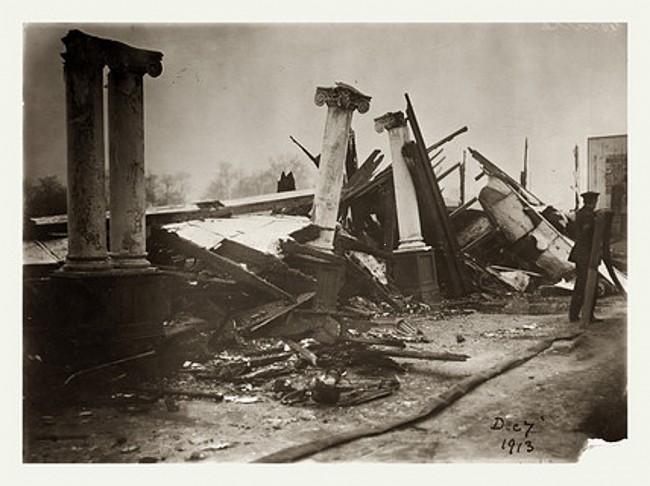
‘Photograph courtesy of Museum of London, Image Number 001303, © Museum of London’
